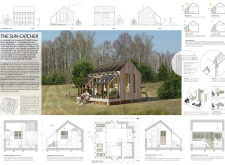5 key facts about this project
The Sun-Catcher is an architectural project designed to integrate sustainable practices with modern living spaces. Focused on energy efficiency and resource management, it exemplifies a holistic approach to residential architecture. The design includes a compact, multifunctional layout that accommodates various living needs while also emphasizing connectivity with nature.
The project emphasizes passive solar design principles, allowing the building to harness natural light and heat. This is achieved through strategically placed operable glazing on the northern facade, which serves as both a greenhouse and a natural light source. The roof is engineered to collect rainwater for use within the home, thereby promoting water conservation.
Sustainable Material Selection
The Sun-Catcher incorporates a thoughtful selection of materials that enhance its sustainability goals. Key materials used include wood for exterior cladding and structural elements, transparent glazing to maximize sunlight, steel for support, cement for foundational stability, and eco-friendly insulation for thermal performance. These materials not only contribute to the building's longevity but also align with the overall design intent of minimizing environmental impact.
Energy Efficiency and Self-sufficiency
One of the project's standout features is its emphasis on energy self-sufficiency. Photovoltaic solar panels are integrated into the design to generate electricity, reducing reliance on traditional energy sources. The efficient layout allows for cross-ventilation, which maintains indoor air quality and comfort without excessive mechanical cooling. This level of energy efficiency is further enhanced by innovative storage solutions and a rainwater filtration system, contributing to a self-sufficient living environment.
Urban Adaptability
The Sun-Catcher also addresses the needs of urban environments by providing a compact footprint that can fit into diverse contexts. The design's flexibility allows for it to adapt to various site conditions, making it a suitable option for both rural and metropolitan settings. The incorporation of green spaces within the project encourages biodiversity and improves residents’ well-being by providing areas for gardening and relaxation.
This project serves as a model for future residential designs that prioritize sustainable living without sacrificing comfort or functionality. To explore the architectural plans, sections, and design details of The Sun-Catcher further, visit the project presentation for a comprehensive understanding of its innovative features and architectural ideas.























